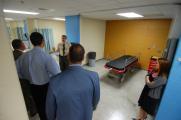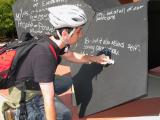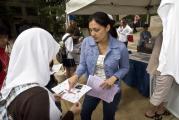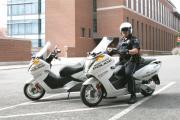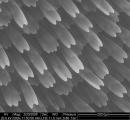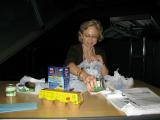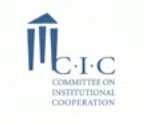Philadelphia, Pa. -- The proliferation of solar, wind and even tidal electric generation and the rapid emergence of hybrid electric automobiles demands flexible and reliable methods of high-capacity electrical storage. Now a team of Penn State materials scientists is developing ferroelectric polymer-based capacitors that can deliver power more rapidly and are much lighter than conventional batteries.
"Electrical energy storage is very important for all electrical and electronic systems," said Qing Wang, associate professor of materials science and engineering. "Even renewable energy systems like solar cells need somewhere to store excess energy to be used at night."
Wang and his research team report today (Aug. 20) at the 236th national American Chemical Society meeting in Philadelphia in two papers, on the development of power density tunable polymers and polymer ceramic nanocomposites as electric storage materials for capacitors. Currently, power conditioning is carried out by capacitors, but Wang believes that eventually properly tuned polymer capacitors could replace batteries.
"Traditional materials are ceramic materials which have high weight and are very fragile," said Wang. "Mobile electronics need light weight electrical energy storage."
The researchers, who include Wang, Yingying Lu, postdoctoral fellow, and Jason Claude, Junjun Li, graduate students in materials science and engineering, developed a polymer of poly(vinylidene fluoride) and trifluoroethylene which, with the addition of chlorotrifluoroethylene had a very high dielectric permittivity at room temperature. Permittivity is a measure of how much charge is stored in a material for a given electric field and is an indicator of how effective a material will be when storing energy in a capacitor. They found that by altering the amounts of the various chemical components of the polymer, they could tune the dielectric property and energy density.
Hybrid cars are a good target for ferroelectric polymer capacitors because for example, when coasting downhill, they convert mechanical energy to electricity and charge batteries for use at other times. Conventional batteries are often heavy and may not be able to deliver the power amounts needed for quick acceleration.
Wang and Li, report on a further modification of this ferroelectric polymer by adding nanoparticulate ceramics to further improve the energy density. Because ceramics often have higher permittivities than the polymers, they believed that combining polymers with high breakdown strength with ceramics of high permittivity would produce a composite material with a large energy storage capacity. Breakdown strength is a measure of the maximum electric field that an insulating material can withstand before it begins to conduct electricity. The higher the breakdown strength, the better a material is for a capacitor.
Unfortunately mixing nano particles of ceramic with polymers is not a simple action. The ceramic particles tend to clump and aggregate. If the two materials are not matched for electrical properties, their interface will breakdown at high electric fields and the ability of the composite to store energy will decrease, rather than increase. Wang and his team fine-tuned the dielectric particles to the polymer matrix by adding functionalized groups to the materials to match them. They also tried to control the mixing so that uniformly dispersed particles are spread through the matrix.
"Matching the permittivity and uniformly dispersing the ceramic nanoparticles is not easy," said Wang. "Both problems have to be tackled and solved at the same time for the material to have the desired characteristics."
Dielectric polymers like the ones Wang creates cannot only be used as capacitors, but could also substitute for the dielectric silicon dioxide layer currently used in computers. Because polymers are processed at room temperature, they are easily fabricated and they are extremely flexible. Their use would open the way for flexible electronics applications, such as foldable screens and computers.
The National Science Foundation and the Office of Naval Research funded this research.
Contact
-
- Andrea Messer
- 814-865-9481
- http://live.psu.edu
-
- Vicki Fong
- 814-865-9481
- http://live.psu.edu



